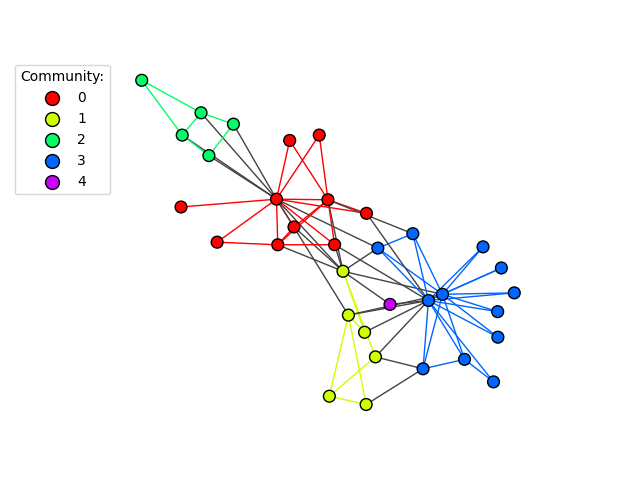Note
Click here to download the full example code
Communities
This example shows how to visualize communities or clusters of a graph.
import igraph as ig
import matplotlib.pyplot as plt
First, we generate a graph. We use a famous graph here for simplicity:
g = ig.Graph.Famous("Zachary")
Edge betweenness is a standard way to detect communities. We then covert into
a igraph.VertexClustering object for subsequent ease of use:
communities = g.community_edge_betweenness()
communities = communities.as_clustering()
Next, we color each vertex and edge based on its community membership:
num_communities = len(communities)
palette = ig.RainbowPalette(n=num_communities)
for i, community in enumerate(communities):
g.vs[community]["color"] = i
community_edges = g.es.select(_within=community)
community_edges["color"] = i
Last, we plot the graph. We use a fancy technique called proxy artists to make a legend. You can find more about that in matplotlib’s Legend guide:
fig, ax = plt.subplots()
ig.plot(
communities,
palette=palette,
edge_width=1,
target=ax,
vertex_size=0.3,
)
# Create a custom color legend
legend_handles = []
for i in range(num_communities):
handle = ax.scatter(
[], [],
s=100,
facecolor=palette.get(i),
edgecolor="k",
label=i,
)
legend_handles.append(handle)
ax.legend(
handles=legend_handles,
title='Community:',
bbox_to_anchor=(0, 1.0),
bbox_transform=ax.transAxes,
)
plt.show()

For an example on how to generate the cluster graph from a vertex cluster, check out Generating Cluster Graphs.
Total running time of the script: ( 0 minutes 0.272 seconds)